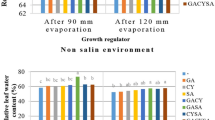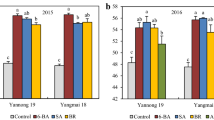Abstract
The fluctuation in temperature adversely affects grain development when the climate changes intermittently. This study investigated the effect of high day/night temperatures (34/30 °C, 38/34 °C and 42/38 °C) for two stress durations (24 h and 48 h) on Triticum aestivum. To ascertain the role of plant growth regulator (PGR) in alleviating the deleterious effects of high temperature stress, the combination of various PGRs (e.g., methyl jasmonate, salicylic acid, ascorbic acid, calcium chloride and indole acetic acid) were foliar sprayed twice; one week prior to commencement of anthesis stage and immediately after the exposure to high temperature stress. In general, the high temperature reduces plant growth, grain setting, and 100-grain weight. High temperature stress causes deterioration of plant photosynthetic machinery through a significant decline in energy dissipation, linear electron flow (LEF) and quantum yield of photosystem II (Phi2) which led to plant death. An increase in the antioxidant enzymes activity (SOD, APX, and CAT) was observed at 38/34 °C, while their activity declined sharply at 42/38 °C. Grain setting and filling were completely inhibited in plants exposed to 42/38 °C even when treated with different combinations of PGRs. Salicylic acid along with methyl jasmonate was the most effective PGR combination resulting in significant improvements in Phi2, NPQt, SOD, grain filling and grain protein content under high temperature stress. A strong correlation was observed between LEF and chlorophyll contents against the number of grains per spike and 100-grain weight. In summary, acute day and night temperature stress adversely affected wheat morphological, physiological, and yield traits, while foliar application of PGRs was partially effective in mitigating these harmful changes.







Similar content being viewed by others
References
Akram NA, Shafiq F, Ashraf M (2017) Ascorbic acid a potential oxidant scavenger and its role in plant development and abiotic stress tolerance. Front Plant Sci 8:613. https://doi.org/10.3389/fpls.2017.00613
Akter N, Islam MR (2017) Heat stress effects and management in wheat, a review. Agron Sustain Dev 37:1–17
Arora NK (2019) Impact of climate change on agriculture production and its sustainable solutions. Environ Sustain 2:95–96. https://doi.org/10.1007/s42398-019-00078-w
Asseng S, Ewert F, Martre P, Rotter RP, Lobell D, Cammarano D, Kimball B, Ottman M, Wall G, White JW (2015) Rising temperatures reduce global wheat production. Nat Clim Change 5:143–147
Calv P, Nelson L, Kloepper JW (2014) Agricultural uses of plant biostimulants. Plant Soil 383:3–41
Caverzan A, Casassola A, Brammer SP (2016) Antioxidant responses of wheat plants under stress. Genet Mol Biol 39:1–6
Chovancek E, Zivcak M, Botyanszka L, Hauptvogel P, Yang X, Misheva S et al (2019) Transient heat waves may affect the photosynthetic capacity of susceptible wheat genotypes due to insufficient photosystem I photoprotection. Plants 8:282. https://doi.org/10.3390/plants8080282
De Ronde J, Cress W, Krüger G, Strasser R, Van Staden J (2004) Photosynthetic response of transgenic soybean plants, containing an Arabidopsis P5CR gene, during heat and drought stress. J Plant Physiol 161:1211–1224
Dhindsa RS, Plumb-Dhindsa P, Thorpe TA (1981) Leaf senescence: correlated with increased levels of membrane permeability and lipid peroxidation, and decreased levels of superoxide dismutase and catalase. J Exp Bot 32:93–101
Ding X, Jiang Y, He L, Zhou Q, Yu J, Hui D, Huang D (2016) Exogenous glutathione improves high root-zone temperature tolerance by modulating photosynthesis, antioxidant and osmolytes systems in cucumber seedlings. Sci Rep 6:35424. https://doi.org/10.1038/srep35424
Djanaguiraman M, Boyle D, Welti R, Jagadish S, Prasad P (2018) Decreased photosynthetic rate under high temperature in wheat is due to lipid desaturation, oxidation, acylation, and damage of organelles. BMC Plant Biol 18:55–63
ElBasyoni I, Saadalla M, Baenziger S, Bockelman H, Morsy S (2017) Cell membrane stability and association mapping for drought and heat tolerance in a worldwide wheat collection. Sustainability 9:1606. https://doi.org/10.3390/su9091606
Fahad S, Hussain S, Saud S, Hassan S, Ihsan MZ, Shah AN et al (2016a) Exogenously applied plant growth regulators enhance the morpho-physiological growth and yield of rice under high temperature. Front Plant Sci. https://doi.org/10.3389/fpls.2016.01250
Fahad S, Hussain S, Saud S, Khan F, Hassan S, Nasim W, Arif M, Wang F, Huang J (2016b) Exogenously applied plant growth regulators affect heat-stressed rice pollens. J Agron Crop Sci 202:139–150
FAO (2016) The state of food and agriculture: climate change, agriculture and food security. FAO, Rome
Hasanuzzaman M, Bhuyan MHM, Zulfiqar F, Raza A, Mohsin SM, Mahmud JA, Fujita M, Fotopoulos V (2020) Reactive oxygen species and antioxidant defense in plants under abiotic stress: revisiting the crucial role of a universal defense regulator. Antioxidants 9:681. https://doi.org/10.3390/antiox9080681
Hemantaranjan A, Nishant Bhanu A, Singh MN, Yadav DK, Patel PK, Singh R, Katiyar D (2014) Heat stress responses and thermotolerance. Adv Plants Agric Res 1:62–70
Hussain J, Khaliq T, Ahmad A, Akhter J, Asseng S (2018) Wheat responses to climate change and its adaptations: a focus on arid and semi-arid environment. Int J Environ Res 12:117–126
Ihsan MZ, El-Nakhlawy FS, Ismail SM, Fahad S (2016) Wheat phenological development and growth studies as affected by drought and late season high temperature stress under arid environment. Front Plant Sci 7:795. https://doi.org/10.3389/fpls.2016.00795
Ihsan MZ, Daur I, Alghabari F, Alzamanan S, Rizwan S, Ahmad M et al (2019) Heat stress and plant development: role of sulphur metabolites and management strategies. Acta Agric Scand Sect B-Soil Plant Sci 69:332–342
Khan MIR, Fatma M, Per TS, Anjum NA, Khan NA (2015) Salicylic acid-induced abiotic stress tolerance and underlying mechanisms in plants. Front Plant Sci. https://doi.org/10.3389/fpls.2015.00462
Khan A, Ahmad M, Ahmed M, Hussain MI (2021) Rising atmospheric temperature impact on wheat and thermotolerance strategies. Plants 10:43. https://doi.org/10.3390/plants10010043
Kuhlgert S, Austic G, Zegarac R, Osei-Bonsu I, Hoh D, Chilvers MI et al (2016) MultispeQ Beta: a tool for large-scale plant phenotyping connected to the open PhotosynQ network. R Soc Open Sci. https://doi.org/10.1098/rsos.160592
Kumar RR, Goswami S, Sharma SK, Singh K, Gadpayle KA, Singh SD, Pathak H, Rai RD (2013) Differential expression of heat shock protein and alteration in osmolyte accumulation under heat stress in wheat. J Plant Biochem Biotechnol 22:16–26
Kumar RR, Goswami S, Singh K, Dubey K, Singh S, Sharma R et al (2016) Identification of putative RuBisCo activase (TaRca1)–The catalytic chaperone regulating carbon assimilatory pathway in wheat (Triticum aestivum) under the heat stress. Front Plant Sci 7:986. https://doi.org/10.3389/fpls.2016.00986
Kumar P, Yadav S, Singh MP (2020) Bioregulators application improved heat tolerance and yield in chickpea (Cicer arietinum L.) by modulating zeaxanthin cycle. Plant Physiol Rep 25:677–688
Lamaoui M, Jemo M, Datla R, Bekkaoui F (2018) Heat and drought stresses in crops and approaches for their mitigation. Front Chem. https://doi.org/10.3389/fchem.2018.00026
Liaqat A, Ihsan M, Rizwan M, Mehmood A, Ijaz M, Alam M et al (2019) Inducing effect of chitosan on the physiological and biochemical indices of eggplant (Solanum melongena L.) genotypes under heat and high irradiance. Appl Ecol Environ Res 17:11273–11287
Liu Y, Ren X, Jeong BR (2019) Night temperature affects the growth, metabolism, and photosynthetic gene expression in Astragalus membranaceus and Codonopsis lanceolata plug seedlings. Plants. https://doi.org/10.3390/plants8100407
Mathur S, Agrawal D, Jajoo A (2014) Photosynthesis: response to high temperature stress. J Photochem Photobiol B Biol 137:116–126
Nakano Y, Asada K (1981) Hydrogen peroxide is scavenged by ascorbate-specific peroxidase in spinach chloroplasts. Plant Cell Physiol 22:867–880
Narayanan S, Prasad P, Fritz A, Boyle D, Gill B (2015) Impact of high night time and high daytime temperature stress on winter wheat. J Agron Crop Sci 201:206–218
Nasim W, Amin A, Fahad S, Awais M, Khan N, Mubeen M, Wahid A, Rehman MH, Ihsan MZ, Ahmad S, Hussain S (2018) Future risk assessment by estimating historical heat wave trends with projected heat accumulation using SimCLIM climate model in Pakistan. Atmos Res 205:118–133
Pospíšil P, Tyystjarvi E (1999) Molecular mechanism of high-temperature-induced inhibition of acceptor side of Photosystem II. Photosynth Res 62:55–66
Poudel PB, Poudel MR (2020) Heat stress effects and tolerance in wheat: a review. J Biol Today’s World 9:1–6
Prasad PV, Boote KJ, Vu JC, Allen-Jr LH (2004) The carbohydrate metabolism enzymes sucrose-P synthase and ADG-pyrophosphorylase in phaseolus bean leaves are up-regulated at elevated growth carbon dioxide and temperature. Plant Sci 166:1565–1573
Quintero-Calderón EH, Sánchez-Reinoso AD, Chávez-Arias CC, Garces-Varon G, Restrepo-Díaz H (2021) Rice seedlings showed a higher heat tolerance through the foliar application of biostimulants. Notulae Botanicae Horti Agrobotanici Cluj-Napoca 49:12120. https://doi.org/10.15835/nbha49112120
Rademacher W (2015) Plant growth regulators: backgrounds and uses in plant production. J Plant Growth Regul 34:845–872
Sage RF, Kubien DS (2007) The temperature response of C3 and C4 photosynthesis. Plant Cell Environ 30:1086–1106
Sarkar J, Chakraborty B, Chakraborty U (2016) Temperature stress induced antioxidative and biochemical changes in wheat (Triticum aestivum L.) cultivars. J Plant Stress Physiol 2:22. https://doi.org/10.19071/jpsp.2016.v2.3076
Sarwar M, Saleem MF, Ullah N, Rizwan M, Ali S, Shahid MR, Alamri SA, Alyemeni MN, Ahmad P (2018) Exogenously applied growth regulators protect the cotton crop from heat-induced injury by modulating plant defense mechanism. Sci Rep 8:1–15
Siddiqi KS, Husen A (2019) Plant response to jasmonates: current developments and their role in changing environment. Bull Natl Res Centre 43:1–11
Teranishi Y, Tanaka A, Osumi M, Fukui S (1974) Catalase activity of hydrocarbon utilizing candida. Yeast Agric Biol Chem 38:1213–1216
Thor K (2019) Calcium-nutrient and messenger. Front Plant Sci. https://doi.org/10.3389/fpls.2019.00440
Thussagunpanit J, Jutamanee K, Sonjaroon W, Kaveeta L, Chai-Arree W, Pankean P et al (2015) Effects of brassinosteroid and brassinosteroid mimic on photosynthetic efficiency and rice yield under heat stress. Photosynthetica 53:312–320
Upreti KK, Sharma M (2016) Role of plant growth regulators in abiotic stress tolerance. In: Rao NKS, Shivashankara KS, Laxman RH (eds) Abiotic stress physiology of horticultural crops. Springer, India, pp 19–46
Wang X, Dinler BS, Vignjevic M, Jacobsen S, Wollenweber B (2015) Physiological and proteome studies of responses to heat stress during grain filling in contrasting wheat cultivars. Plant Sci 230:33–50
Zhao X, Chen T, Feng B, Zhang C, Peng S, Zhang X et al (2017) Non-photochemical quenching plays a key role in light acclimation of rice plants differing in leaf color. Front Plant Sci. https://doi.org/10.3389/fpls.2016.01968
Ahmad M, Siftain H, Iqbal M (2014) Impact of climate change on wheat productivity in Pakistan: a district level analysis. PIDE Climate Change Working Paper Series, 1. Pakistan Institute of Development Economics, Islamabad, pp 1–28
IDRC (2010) Facts and Figures on Food and Biodiversity. Canada: IDRC Communications, International Development Research Centre. https://www.idrc.ca/en/research-in-action/facts-figures-food-and-biodiversity
Acknowledgements
The authors would like to extend their sincere appreciation to the Researchers Supporting Project number (RSP-2021/347), King Saud University, Riyadh, Saudi Arabia.
Author information
Authors and Affiliations
Contributions
MZI and SF designed the experiment, MZI and LA conducted the experiment, HMA, RK, MHS analysed the data, AM evaluated statistical model on the data, MZI and LA wrote the manuscript, AK, RK, MHS edited the manuscript.
Corresponding authors
Ethics declarations
Conflict of interest
The authors declare that they have no conflict of interest.
Additional information
Handling Author: Peter Poor.
Publisher's Note
Springer Nature remains neutral with regard to jurisdictional claims in published maps and institutional affiliations.
Rights and permissions
About this article
Cite this article
Ihsan, M.Z., Khaliq, A., Siddiqui, M.H. et al. The Response of Triticum aestivum Treated with Plant Growth Regulators to Acute Day/Night Temperature Rise. J Plant Growth Regul 41, 2020–2033 (2022). https://doi.org/10.1007/s00344-022-10574-9
Received:
Accepted:
Published:
Issue Date:
DOI: https://doi.org/10.1007/s00344-022-10574-9




